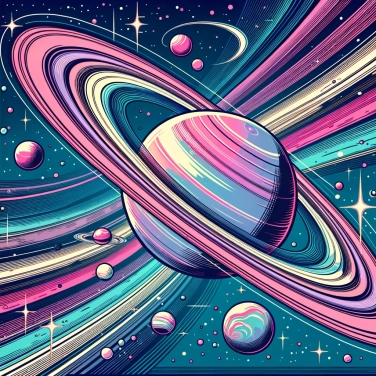The rings of Saturn remain in place due to the balance between the planet's gravity and the centrifugal force of the particles making up the rings, preventing them from falling towards Saturn.

The rings of Saturn likely come from the debris of a moon or a comet that got a bit too close and was torn apart by the planet's strong tidal forces. This debris ended up in orbit, revolving around Saturn without being able to regroup into a new object due to the intense gravity. Over time, they spread out into a thin ring primarily composed of ice and dust. This ice reflects light very well, hence the characteristic brightness of the rings we admire today.
The rings of Saturn are made up of a myriad of small particles, primarily composed of ice and a bit of dust. Each one orbits Saturn at a certain speed, which gives it a centrifugal force. This force is exactly what is needed to counteract the attraction of the planet, its gravitational force, which constantly tries to pull these particles back toward it. Essentially, these tiny pieces orbit at just the right speed: not too slowly (they would be drawn into Saturn), and not too quickly (they would fly further into space). All these particles naturally balance each other in a kind of ultra-precise cosmic dance, resulting in surprisingly regular flat and stable rings around the planet.
Some of Saturn's satellites, known as shepherd moons, act as the flock's guardians: they keep the rings neatly in order. Their presence prevents the particles in the rings from escaping too much or scattering everywhere thanks to their gravitational attraction. For example, two small shepherd moons, Pandora and Prometheus, flank the F ring. As they orbit around Saturn, they exert a subtle yet effective gravitational influence that constantly reshapes the edges of this ring. In this way, the ring avoids becoming blurred or diffuse. Without these little satellites to enforce the boundaries, the rings would be much less precise and spectacular.
The particles in Saturn's rings orbit the planet, some experiencing orbital resonances, which are sort of regular rendezvous with nearby moons. These repeated encounters create stable and unstable zones, the latter forming distinctive gaps like the famous Cassini division. As the moons orbit, their gravity regularly gives a little push to the ring particles, either adding or subtracting orbital energy from them. As a result, some trajectories stabilize neatly, while others quickly become clear, revealing those marked "holes" or divisions that we observe from Earth. These resonances are therefore a key factor in maintaining the neat and orderly structure of the rings.
The planet Saturn exerts a particularly powerful gravitational attraction on the billions of icy particles that make up its rings. It is this large global gravitational field that prevents the particles from escaping into space or falling towards the planet. At a certain distance, these icy elements orbit Saturn at a speed sufficient to maintain a balance. Thanks to this precise balance, known as orbital balance, each particle remains on its very stable orbit, quietly rotating without spiraling out of control. This global phenomenon creates clear zones of magnificent and distinct rings around the planet, giving the rings their flat and perfectly ordered appearance.
Although Saturn's rings appear immutable to our eyes, their structure is constantly evolving. Some particles are drawn towards Saturn, while others are held in place or replenished through impacts with small bodies such as meteoroids.
Saturn is not the only planet in the solar system with rings: Jupiter, Uranus, and Neptune also have them, but these rings are much more subtle and harder to observe from Earth.
Astronomers predict that Saturn's rings will disappear in about 100 million years due to gravitational interactions with Saturn and its moons, which gradually pull the particles towards the planet.
The particles that make up Saturn's rings vary in size, ranging from tiny grains of ice to blocks the size of a house. However, they are predominantly made up of pure water ice, comprising over 90%.
No, the particles closer to the planet orbit faster than those situated further away, in accordance with Kepler's laws. This difference in orbital speed explains the complex and dynamic structures observed in the rings.
Some moons, known as shepherd moons, play a crucial role in maintaining the cohesion and stability of the rings through their gravity. By orbiting nearby, they limit the dispersion of particles and sculpt the precise contours of the rings.
The rings of Saturn are primarily composed of water ice particles, mixed with smaller dust and rock debris. Their size ranges from tiny grains of dust to fragments as large as a house.
The exceptional brightness of Saturn's rings primarily comes from the ice particles they contain. The ice reflects sunlight very efficiently, giving the rings their characteristic bright shine.
Yes, other gas giants in our solar system, such as Jupiter, Uranus, and Neptune, also have ring systems, but these are generally much thinner, darker, and less visible than those of Saturn.
Yes, the rings of Saturn are constantly losing material. The particles gradually fall towards the planet due to gravity and electromagnetic interactions. According to some estimates, the rings could completely disappear in a few hundred million years.

No one has answered this quiz yet, be the first!' :-)
Question 1/6